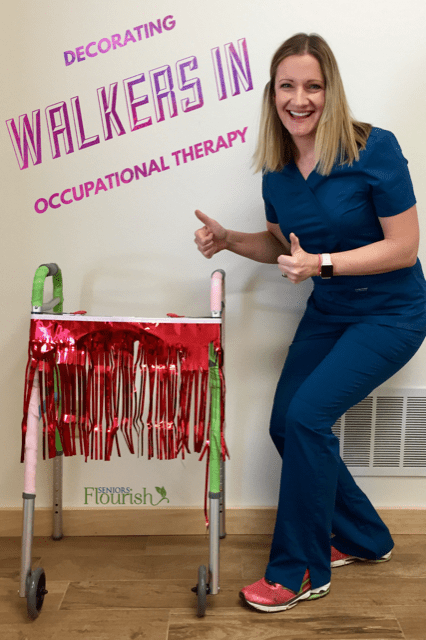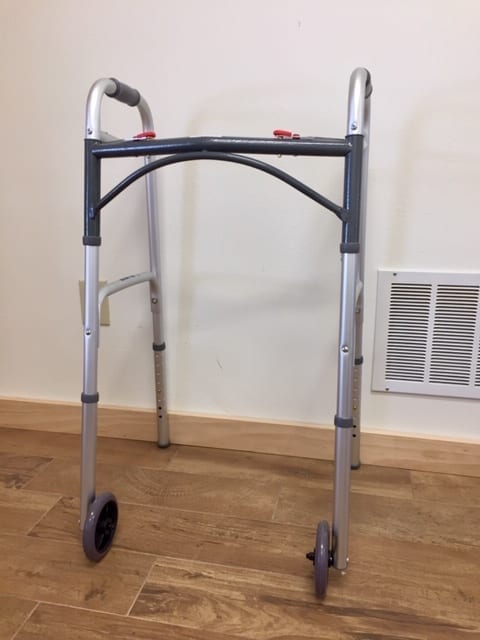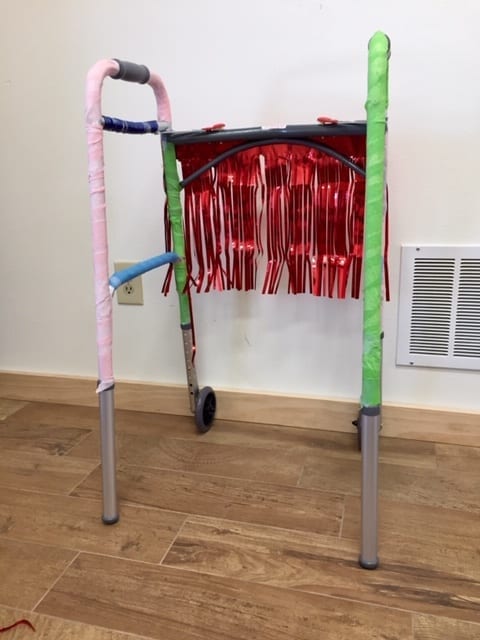When you Google “decorating a walker in OT,” all sorts of things pop up like: “bedazzling walkers,” “pimp my walker,” “decorate rollator,” etc and WOW are people creative!
But how do we, as occupational therapy practitioners, actually use decorating a walker as a tool in our therapy sessions and what types of goals can we work on while having this much fun?!?

Things to consider before diving in on the decorating including the client’s:
- reason to decorate – fun? increased visual perception? increased use? sense of identity?
- likes – colors? amount of flair? fancy? flashy? bling? cultural considerations?
- facility’s infection control policies…
3 Reasons to Decorate a Walker for OT Treatment Sessions
1. Increase Ability to See the Walker
We all know those clients – no matter how many times you cue them to use their walker, they just don’t use it? I would recommend to screen for visual perceptual issues or low vision. A regular walker has very little color contrast and if you put it against a beige or white wall, it could be really hard to see!
No one is going to use something that they cannot see, especially if it is a new assistive device for them.
Plus, for clients with dementia, out of sight definitely can mean out of mind and having that visual contrast increases visual cuing for them to use it.
2. Increase Safety Awareness
I worked at a facility where we were having a large number of falls from residents forgetting their walkers. We were brainstorming and the occupational therapists decided, in conjunction with other fall reduction strategies (toileting schedule, balance training, good footwear, etc), to help the clients decorate their walkers.
It became a “thing” at the facility and it quickly became a contest between the residents who could make theirs the most creative or personalized. We found that even the residents that demonstrated dementia seemed to recognize which walker belonged to them due to the personalization (we did favorite colors, fake flowers, rhinestones on walker cups and glitter washi tape) and found they actually used them more often, ultimately reducing facility falls.
Other facilities around the world have utilized this strategy and have found a reduction in facility falls up to 60%.

3. Use Decorating as a Meaningful Activity to Work on Performance Components
If decorating a walker is something meaningful to the client, you can also work on many performance components that contribute to your OT goals.
[thrive_2step id=’13917′]-> Click here for an OT Performance Components Reference PDF <-[/thrive_2step]
For example:
If the client is working on standing tolerance in order to be able to stand at sink side to complete their morning hygiene routine, you can time how long the client is able to stand while performing the dynamic standing task of decorating the walker.
If the client is working on bilateral integration of their upper extremities for independence in feeding, you can have them decorate the walker and use the affected upper extremity as a stabilizer of the walker while they are putting on the tape or even using both hands to string a sign on the front.









1 thought on “3 Reasons to Decorate a Walker in OT”
What a wonderful idea should be more of this communication and information around.